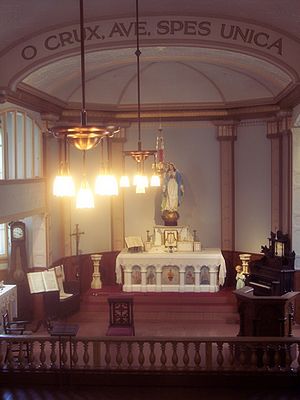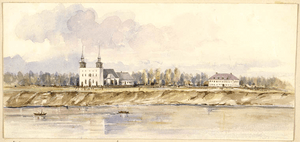Le Musée de Saint-Boniface Museum facts for kids
 |
|
| Established | 1959 |
|---|---|
| Location | 494 Taché Ave Winnipeg, Manitoba, Canada R2H 2B2 |
| Type | Civic museum |
| Public transit access | 10 St. Boniface - Tache 56 Aulneau |
Le Musée de Saint-Boniface Museum, also known as the St. Boniface Museum, is a special place in Winnipeg, Manitoba. It tells the story of the Franco-Manitoban (French-speaking people from Manitoba) and Métis people.
The museum is inside a very old building that used to be a convent for the Grey Nuns. It is the second-oldest building in all of Winnipeg! Construction on the building started in 1846. Over the years, it has been an orphanage, a school, a home for seniors, and even the very first St. Boniface Hospital.
The museum works with other important groups like the Canadian Museums Association and the Canadian Heritage Information Network.
Contents
A Building with a Long History
The first Grey Nuns arrived in the area in 1844. They lived with Bishop Norbert Provencher while their new home was being built. Four nuns moved into the building in December 1846. At the time, it was not even finished.
To stay warm during the cold winters, the nuns got creative. They hung thick bison pelts from the ceiling to keep the heat in their room.
A Special Way to Build
When the building was finally completed in 1851, it had a basement, two floors, and an attic. It was built using a special method called the Red River style. This method, also known as mortise and tenon, fits pieces of wood together like a puzzle. Amazingly, the entire building was constructed without using any nails.
From Convent to Museum
The building served the community in many ways for over 100 years. In 1958, it was named a National Historic Site of Canada because of its importance.
A year later, in 1959, the local government decided to turn the old convent into a museum. The City of Winnipeg has taken care of the building since 1971.
What Can You See at the Museum?
The museum has many exhibits that show what life was like for the Franco-Manitoban and Métis people. You can learn about their culture, traditions, and important contributions to Canada's history.
The Louis Riel Exhibit
One of the most famous exhibits is dedicated to Louis Riel, an important Métis leader. The museum has many of his personal belongings.
Visitors can see locks of his hair, his revolver, and his shaving kit. The exhibit also includes his moccasins and other items that belonged to him. There are also important artifacts related to the end of his life, including the coffin his body was placed in after his execution.


